While works of talented choreographers whose heritage is in modern dance pop up in parks, churches, lofts, barns, and theater like mushrooms after a good storm, gifted new choreographers working in the ballet idiom are rarer and therefore get a lot more attention. Remember the fuss surrounding Eliot Feld when he began choreographing in 1967 while still performing in American Ballet Theatre? Remember the excitement aroused by Christopher Wheeldon’s debut? Or Benjamin Millepied’s first ballets?
These days, ballet companies commission works by Mark Morris, say, or Jirí Kylían—choreographers not concerned with the classical language. But choreographers do emerge who want to utilize aspects of ballet tradition and yet explore new ways to extend or subvert it. Cherylyn Lavagnino is one of these. Jessica Lang is another. A Juilliard graduate who performed for a while with Twyla Tharp’s company, THARP!, Lang has, since 1999, set works on numerous companies, including the Birmingham Royal Ballet, the Joffrey Ballet, Ballet San Jose, Ailey II, and ABT.
Lang has recently formed her own small company, and its engagement at Jacob’s Pillow (July 25-29) marked its “full company debut.” She’s a talented choreographer with a style that she seems still to be pondering and developing to advantage. For instance, at the Pillow, her 2006 The Calling, excerpted from Splendid Isolation II, is a solo for a dancer wearing an immensely long white skirt that spreads out around her in a circle (I saw tall, beautiful, reed-thin Kana Kamura perform the role; Clifton Brown took it over at other performances). In a pool of light, to the plainchant hymn “O Maria, Stella Maris” sung hauntingly on tape by Trio Medieval, she bends and twists slowly within the garment. When she sinks down briefly, straight-spined, the fabric (some kind of lightweight jersey perhaps) creates the unearthly illusion that she is sinking into sand or being swallowed by foam. Star of the sea indeed.
The extracted solo is short and inconclusive, but it is far more powerful and consistent than a duet excerpt from Splendid Isolation, as performed by Irina Dvorovenko and Maxim Beloserkovsky of ABT in an online video. In this clip, it seems far too easy for the ballerina to hitch up her skirt, show her legs, and step out onto pointe, before divesting herself of the skirt entirely for some conventional ballet duetting.
(http://www.youtube.com/watch?v=WUZENnXOeXc)
One admirable aspect of Jessica Lang Dance’s program in the Pillow’s Doris Duke Studio Theater is her awareness of space and her interest in altering it through scenery, costumes, and props. She doesn’t use these as decoration or mood enhancers but as elements that shape the choreography. For her world premiere, Lines Cubed, molo designers Stephanie Forsythe and Todd McAllen worked with her in order to echo the black grids and blocks of color in a Mondrian painting. The dancers themselves pull out and retract black, accordion-pleated walls and the blocks of primary color that come and go on the dark-lined white backdrop.
At first, the dancing by nine performers in trim black costumes by Lisa Choules is staccato. They march, stick both arms straight up, or out in front of them as if to say “halt.” Their patterns, although two-dimensional, do indeed cube the imagery of Mondrian’s flat designs. When Maggie Small (I think it was she) sticks a straight leg out in front of her, and Kirk Henning lifts that leg and cranks it down, elevating her, it’s as if he’s jacking up the whole design.
Like Mondrian, Lang plays with a basic color palette. In one section, the four men (Brown, Thomas Garrett, Henning, and Milan Misko) who carry Kimura around and fall to the floor so she can step over them all wear red versions of the basic outfit. In another episode, Julie Fiorenza, Laura Mead, and Small cavort in yellow. Voices and popping or tinkling percussion surface in John Metcalfe and Thomas Metcalf’s score, and Nicole Pearce illuminates the goings-on with excellent, clear lighting.
The most intimate connections between dancers and set occur when Claudia McPherson and Milan Misko (both wearing blue) must manage their encounter between and across the pleated barriers manipulated by others. In the end, the dancers all return in their black, red, yellow, and blue attire to reprise the piece’s opening (with variations) and form a three-dimensional structure out of linear poses.
Lang shows off her dancers very intelligently, balancing the program between group works, solos, and duets. Solo Bach (2008) is as dense as Splendid Isolation is spare. In it, Kanji Segawa almost never stops moving. It’s as if he daren’t pause, because J.S. Bach’s Partita No. 3 in E Major for violin keeps diving and bubbling ahead, and Lang affixes her choreography tightly to it. Segawa, a strong, resilient performer, finds ways to make his dancing breathe a little— sinking into some of the moves before vaulting onward.
Solo Bach is the only piece danced on a bare stage. Among the Stars (2010) features a long strip of sheer fabric that lies along the floor like a pale river. The duet begins to quiet keyboard music by film composer Ryuichi Sakamoto. Wearing the cloth like a train, Small, on pointe, walks away from us on a long diagonal, while Brown, on the floor at the other end of the cloth, reaches out to her. When she divests herself of the “skirt,” the two of them run on either side of it, restless in their separate worlds.
Having clearly established the cloth as a symbolic barrier between them, Lang proceeds to vary and play with that idea. Although some potentially poignant, visually lovely images emerge, the significance of the cloth and its emotional resonance blur. The two dancers trudge toward it from opposite directions, bunching it up with their feet. They lie side by side on it. Small leaps across it into Brown’s arms. She wraps herself briefly in it. He holds the middle of it across his arms like an offering, while she lies, crumples and inert. In the end, Small is standing, twisting, while Brown makes the cloth wrap around her feet like a snare. After a while, you stop sympathizing with two lovers combating an obstacle and think things like, “why are they doing that?” or “that’s a gorgeous effect.”
Lang created From Foreign Lands and People for the Colorado Ballet in 2005. In this case, her set—five long, square-edged black boxes—isn’t meant as an arena for emotions. Instead it’s a playground for eight nimble, affectionate adults, accompanied by Robert Schumann’s Kinderszenen Opus 15 (sensitively played by pianist Taka Kigawa). It’s fascinating to watch the near-constant manipulation of the components, as they’re laid on their sides, tilted, propped on others to form slides, erected as pillars, and built into structures for dancers to climb and hang from. Todd Clark’s lighting, recreated by Pearce, is also a crucial ingredient.
Lang skillfully reconfigures the space with constructions both human and inhuman. In one clever passage, Henning partners Julia Fiorenza, while the remaining three men partner the pillars. There’s a very nice brief duet for Brown and MacPherson and a quick solo for her after he departs. People pair up and dance together, but there’s always a sense of them as workers, busy transforming their world to accommodate one another’s games.
The dancers are all excellent, although at this point, they don’t seem unified as to performance style. During his years with the Alvin Ailey American Dance Theater, Brown was always a wonderfully expressive performer—unmannered and truthful. I see that kind of alertness and openness in Mead and Henning, while others sometimes seem less there. Small counters this neutrality with too-generic facial expressions—a sparkly smile in the trio in Lines Cubed and a pained look in Among the Stars. Brown, now Lang’s rehearsal director, has his work cut out for him. The company is still defining itself, even as it embarks on the road to success.
Jessica Lang Dance’s performance started me, once again, into thinking about pointe shoes. Lang employed them hardly at all in this program (nor, to her credit, did she propagate standard ballet feats). Great ballet choreographers like Balanchine exploit the speed, intricacy, delicacy, and power that the shoes can facilitate. Tudor used them to heighten emotion; a step into an arabesque on pointe in could suggest climbing an internal mountain. Contemporary choreographers committed to ballet sometimes ignore the shoes’ potential and simply use them as a clean-lined extension of a woman’s legs.
Cherylyn Lavagnino, once a dancer in the Pennsylvania Ballet and other companies, has been working for some years to find contemporary ways to use pointework. She’s a colleague of mine on the faculty of New York University’s Tisch School of the Arts, so I’ve watched her strive to combine some of the earthiness of contemporary dance with ballet to create unusual partnering, ways of deploying dancers in space, and how pointe shoes may contact the floor.
Her company, Cherylyn Lavagnino Dance, formed in 2000, is a modest-sized ensemble, and her sensitive, intriguingly poetic compositions look wonderful in St. Mark’s church, where it performed at the end of June in Danspace Project’s season in splendid lighting designed by Kathy Kaufman. Lavagnino’s choreography has a particular tang; movements and relationships may begin conventionally, but turn out unexpectedly, and her dancers are all strong, thinking performers.
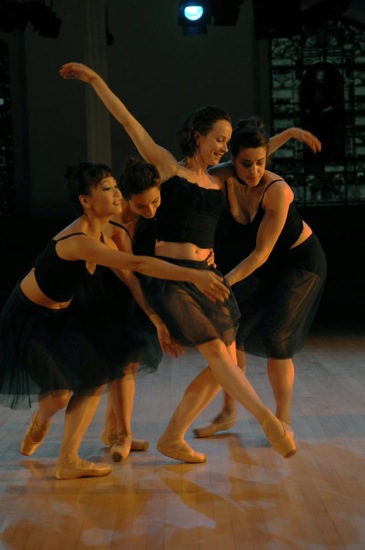
L to R: Selina Chau, Sara Bek, Laura Mead, and Claire Westby in Ménage. Photo: Kokyat, courtesy Philip Gardner and Oberon’s Grove
Lavagnino’s 2009 Ménage, seems to allude, very subtly, to an earlier ballet world—that of the Paris Opera studios painted and sculpted by Degas. Although the music by Scott Killian, Jacob Lawson, and Jane Chung is contemporary, and Naoko Nagata has costumed the four women in its cast in black net skirts and corselets that bare their midriffs, the atmosphere and the attitudes hint at flirtations, rivalries, and friendships—a few seconds of gossip here, a bit of preening there. Selina Chau presses one toe against the floor—half making a decorative pose, half testing her slipper. Claire Westby even wears a black ribbon choker like Degas’ gauche 19th-century ballet girls. Two men (Justin Flores and Eric Williams), garbed in cut-off tights and vests, but no shirts, stroll onto the scene arm-in-arm, like gentlemen patrons casing the green room. They and Joshua Palmer partner the women in ways that show the body’s awkwardness as well as its grace, but they also assume ballroom positions with one another.
Curious passages occur. Laura Mead (as fine in Lavagnino’s work as she is in Lang’s) lies for a long time on the floor. Willams and Sara Bek glance at her and get on with their courtship—he swirling her into the air. Flores steps over Mead on his way to Chau. When Mead sits up and Palmer kneels beside her, she smooths the floor with one hand, as if looking for a message in the sand before she rises and they dance together.
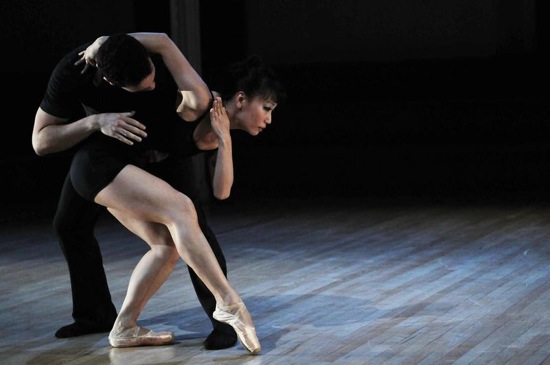
Joshua Palmer and Selina Chau in Deux en Peu. Photo: Kokyat, courtesy of Philip Gardner and Oberon’s Grove
Chau and Palmer encounter each other in the 2012 duet Deux en Peu. The andante from Schubert’s Trio in E Flat Major is sweeter than they are. He watches her stride into the space, bold in her steps and stances. Their encounter could be a chance one, but it also suggests a confrontation They seem to be finding ways to fit together, whether that means lying on the floor, spoon-fashion or engaging in more elaborate maneuvers—he lifting her onto his shoulder or she swooning backward over his arm. It ends with her repeating her opening theme, a queen bee not sure she needs a sexily accommodating drone. Chau is a highly accomplished, expressive dancer, but at times she projects a balletic hauteur that seems out of keeping with the terrific Palmer’s simpler, more direct approach.
Lavagnino’s new Triptych is a mysteriously beautiful work, enhanced by the American Virtuosi’s live performance of François Couperin’s Troisieme Leçon à deux voix (1714) for the first movement and Heinrich Fried Ignaz Biber’s Passacaglia for Solo Violin (finely played by Jane Chung) for the third. The period-instrument ensemble led by Kenneth Hamrick also gifts us with an overture (the second of Couperin’s Concerts Royaux). Scott Killian’s commissioned score (heard on tape) for the second movement draws on Baroque vocal music, which allies it in an understated way with the glorious sound of countertenors Eric S. Brenner and Nicholas Tamagna singing the Couperin, their voices twining around each other.
Couperin’s piece is one of his sacred Leçons de Ténèbres; its Latin text, drawn from the Book of Lamentations, mourns the destruction of Jerusalem as God’s punishment (“behold and see if there be any sorrow, like unto my sorrow. . .wherewith the Lord hath afflicted me in the day of his fierce anger”).
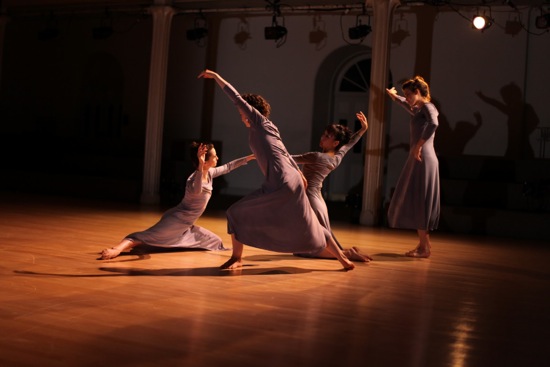
L to R: Giovanna Gamna, Laura Mead, Selina Chau, and Claire Westby in Triptych. Photo: Ella Bromblin
Lavagnino’s Triptych, beautifully suited to the muic and Saint Mark’s church, begins eerily with Christine McMillan moving quietly on the balcony and looking down at where five men have gathered (those mentioned plus Michael G. Cameron and Samuel Swanton). The mood is as elegiac as the hanging panels that show Betsy Weis’s haunting digital photos of misty lakeside landscapes in black and gray. Sometimes the wall behind these turns blue, sometimes rust. Four of the men lift Palmer as if on a bier. In a corner, five women—now including Giovanna Gamna–form chain—reaching out to one another, leaning into the empty space around them. Their simple dresses are gray. Everyone is barefoot.
The dance landscape is changeable. You sense a community scattering but drawn together in contrapuntal patterns. People enter and leave, cling together in trios, lift one another in duets, fall into receiving arms, lean on one another, fly into leaps. Eventually McMillan descends from the balcony to join. The throng. Lavagnino lets us see the performers as individuals, each in a solitary moment, or several moving in their own private worlds at the same time. Men and women dance in counterpoint, or join into couples. In the second movement, two men (Williams and Flores) sustain each other in a somber duet, and Chau returns on pointe—I’m not sure why—for a tense pas de deux with the latter. The lighting casts the shadows of branches on the floor. In the end, all the dancers stand together, ready for what may come.
Eloquence must be something Lavagnino asks of her dancers. You often feel the movement as it courses through their bodies gently or fiercely. The distortions don’t look like examples of the new virtuosity, and at their best, they seem to proceed from emotional states. The dancers gaze intently at one another and the space, while the choreography bends the ballet vocabulary to suit whatever possesses them, or invades them from the music.

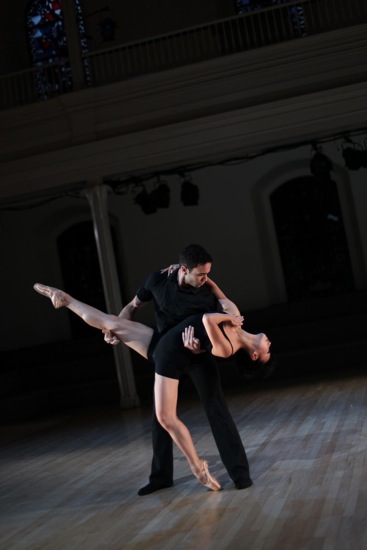
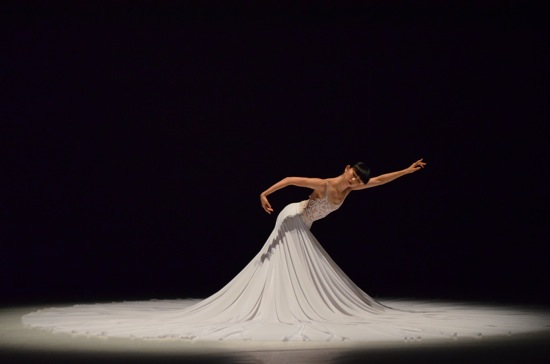
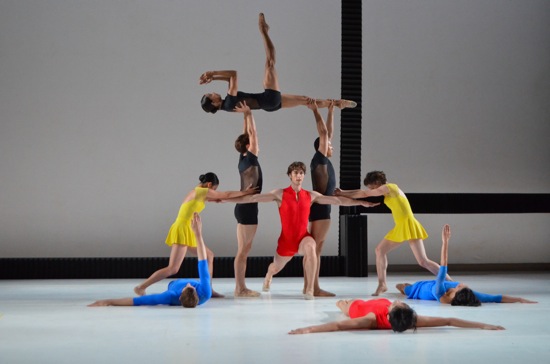
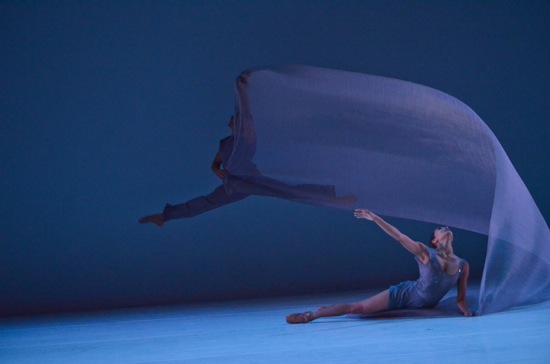
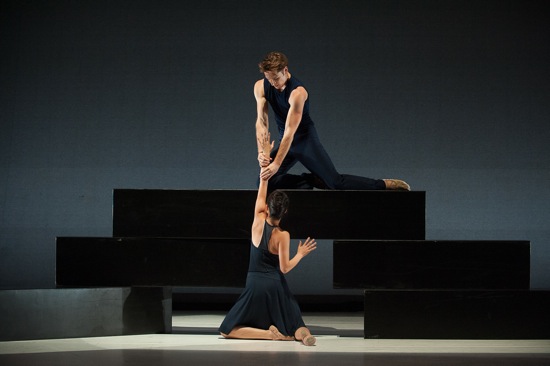
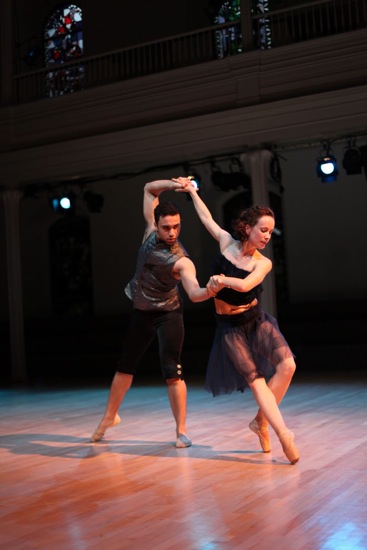
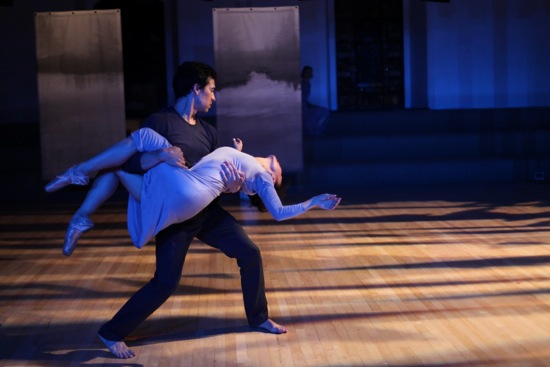
From your description it sounds like Lang is using ballet as movement material, but several of the photographs reminded me of classic modern dance works. Graham, Humphrey, St. Denis and Nikolais all seem to be making an appearance in her staging.
Also Loie Fuller, particularly the solo from “The Calling.” I’ve only seen Lang’s work on video, alas, but it is noteworthy I think that Toni Pimble, artistic director of the Eugene Ballet, after seeing Lang’s work performed by Kansas City Ballet, on whom she had made a piece as well, programmed something for EBC by Lang which I didn’t get to see, last season. What strikes me about the photos and video of Lang’s work is how intensely visual she is. Anyway, thanks Deborah for such vivid and meticulous description.
I missed Fuller — I was thinking St Denis for that one! But we both missed the Graham connection.
Thinking about ballet choreographers who’ve used props/costumes in a similar fashion, but I’m not getting any further than Balanchine (the Siren’s train in Prodigal, the woman’s extended costume in Variations pour une porte et un soupir). Maybe Tudor, but though the costumes for his works certainly underline the qualities he gives his characters, I don’t know that they really become a part of the choreography.
Ooops — missed the swaddling at the beginning of Apollo — and since I’ve been regretting that the local company dropped the birth scene this year, I’m extra embarrassed at the slip!
I learn something from you every time — about writing, about choreography, about performance, costuming, aesthetics, emotions — thank you!